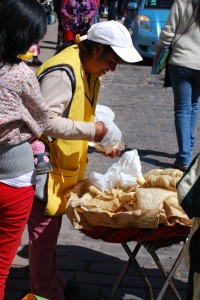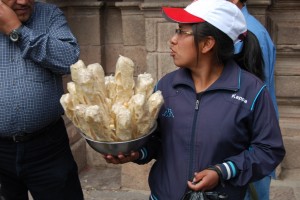Cuzco’s Snack, Toqto and Cancha

Cities not only have food, they have snacks, those tidbits you just have to much on because they are there. One of Cuzco’s favorite nibbles is a crunchy puff of air with a slight bacony flavor accompanied by salty, substantial parched corn. Toqto and cancha, they are called. They just come together like best friends, or an old couple where the one is not without the other.
While Cuzco’s young men battle it out on the soccer field, sweat flying from their faces, women dare to walk between the crowd, hanging on step and every roll of the ball, to offer bags stuffed with off-white toqto and golden yellow cancha.
While troupes of dancers bounce and fall around Cuzco’s main Plaza through a channel of tightly packed spectators, women and men move in between them or behind them, their hands held out with packages of toqto.
Many street corners hold women sitting by a bundle wrapped in heavy paper with toqto and chanchas spilling out to tempt passersby.
And, it is tempting. Made from pork skin soaked over several days in many waters before being deep fried and inflating into a sponge, toqto is light and crunchy. Broken into pieces for sale, its dry crunchy sounds, as the pieces bump into each other may be the source of its name. With each bump and each pop they sound “toq, toq, toq”.

Or it may come from the open spongy-ness of the finished product.

But whatever the source and whatever the meaning of the name–still awaiting investigation–the toqto tastes good. It is almost impossible to just eat one.
Cancha, toasted and salted corn that when chewed breaks with a crunch into a flash of powder is similar with its external crunch and then air. But cancha was one of the staples of the indigenous civilizations of the Andes, such as the Incas, and remains a staple of Cuzco.
Together they are a revelation, though they form a background to everything else. Popped in the mouth little by little they keep wait until a goal is scored and people leap up shouting in joy or groaning in anguish. They do their work while dancers demonstrate grace and athleticism through Cuzco’s street. Or, they supply some energy while one moves through the crowded streets to meet a friend or plan the next day’s treks.

The toqto and cancha is made in people’s homes to sell and add to their household economy, although it is most characteristic of the southern end of the Cuzco Valley, such as the town of Saylla. There, where chicharrón is a specialty, streets find glassed in displays of fresh toqto to tempt the passersby to come in and enjoy some food.
Toqto and cancha are Cuzco, a dyad of Spain and Inca, separate yet joined.

Note on Spelling:
Rosario Olivas Weston, in her book on Cuzco cuisine, spells the word “tocto“. That is how it sounds to ears trained in Spanish, but that Quechua stop after the vowel is what changes the vowel sound from the normal “u” to something more like a long “o”. A “c” or a “k” does not make that transformation, but a “q” does. So, I have opted for a more quechua-ish spelling, “toqto”although almost everyone whose primary language is Spanish will insist on the c. However, if I were to really be a purist on Quechua then I would spell it “tuqtu”, and just let the “q” do its work.




